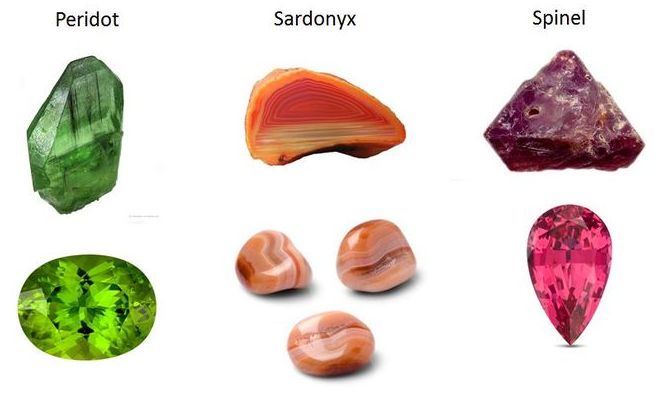 In 2016, August joined June and December as one of the three birth months represented by three gems.
In 2016, August joined June and December as one of the three birth months represented by three gems.
The original birthstone for August was Sardonyx, and then peridot was added, becoming August’s primary gem. The addition of spinel, which can be found in a variety of colors, gives August babies a plethora of options!
Learn more about August’s diverse birthstones by exploring below:
 PERIDOT
PERIDOT
 |
| Lika Behar Collection |
Though peridot is widely recognized by its brilliant lime green glow, the origin of this gem’s name is unclear. Most scholars agree that the word “peridot” is derived from the Arabic faridat which means “gem,” but some believe it’s rooted in the Greek word peridona, meaning “giving plenty.” Perhaps that’s why peridot is associated with prosperity and good fortune.
Peridot is the rare gem-quality variety of the common mineral olivine, which forms deep inside the earth’s mantle and is brought to the surface by volcanoes. In Hawaii, peridot symbolizes the tears of Pele, the volcano goddess of fire who controls the flow of lava.
Rarely, peridot is also found inside meteorites.
Peridot’s signature green color comes from the composition of the mineral itself—rather than from trace impurities, as with many gems. That’s why this is one of few stones that only comes in one color, though shades may vary from yellowish-green to olive to brownish-green, depending how much iron is present.
Most of the world’s peridot supply comes from the San Carlos Reservation in Arizona. Other sources are China, Myanmar, Pakistan and Africa.
Peridot only measures 6.5 to 7 on the Mohs scale, so while the raw crystal is prone to cracking during cutting, the finished gemstones are fairly robust and easy to wear.
Also known as “the Evening Emerald” because its sparkling green hue looks brilliant any time of day, peridot is said to possess healing properties that protect against nightmares and evil, ensuring peace and happiness. Babies born in August are lucky to be guarded by peridot’s good fortune.
 |
| Gabriel & Co. |
Peridot jewelry dates back as far as the second millennium BC. These ancient Egyptian gems came from deposits on a small volcanic island in the Red Sea called Topazios, now known as St. John’s Island or Zabargad.
Ancient Egyptians called peridot the “gem of the sun,” believing it protected its wearer from terrors of the night. Egyptian priests believed that it harnessed the power of nature, and used goblets encrusted with it to commune with their nature gods.
Some historians believe that Cleopatra’s famed emerald collection may have actually been peridot. Through medieval times, people continued to confuse these two green gems. The 200-carat gems adorning one of the shrines in Germany’s Cologne Cathedral were long believed to be emeralds as well, but they are also peridots.
This gemstone saw a revival in the 1990s when new deposits were discovered in Pakistan, producing some of the finest peridots ever found. Some of these “Kashmir peridots” measured more than 100 carats.
The most productive peridot deposit in the world is located on the San Carlos Apache Indian Reservation in Arizona. An estimated 80 to 95 percent of the world’s peridot supply is found here.
Thanks to these rich deposits, the modern demand for peridots can now be met easily, giving people born in August affordable options for wearing this beautiful green birthstone.
 SARDONYX
SARDONYX
Sardonyx combines alternating layers of sard and onyx—two types of the layered mineral chalcedony—to create a reddish zebra-striped stone with white bands.
Its name, similarly, combines sard (referencing the ancient Persian city, Sardis, in present-day Turkey, where the red stone was found) with onyx (from the Greek word of the same spelling, which meant “nail or claw.”)
Sard ranges in color from yellowish red to reddish brown, depending on how much iron oxide is present. Sard is easily confused with carnelian, another type of chalcedony that is slightly softer and lighter in color.
Sardonyx, like onyx, shows layers of parallel bands—instead of the chaotic, curved bands that compose agate, another type of chalcedony.
The finest examples of sardonyx, which display sharp contrasts between layers, are found in India. Other sources include Brazil, Germany, Czechoslovakia, Madagascar, Uruguay and the United States.
Measuring 6.5 on the Mohs hardness scale, sardonyx is widely available and relatively inexpensive as gems, beads, and jewelry. It is often carved into cameos, intaglios and brooches to show the color contrast between layers.
Used as a stone of strength and protection since ancient times, sardonyx is associated with courage, happiness, and clear communication. Some believe that placing sardonyx in each corner of a house will grant protection against evil.
Sardonyx has been popular for centuries, dating back to the Second Dynasty of Egypt more than 4,000 years ago.
Ancient Greeks and Romans went to battle wearing sardonyx talismans engraved with images of heroes and gods like Hercules and Mars. They believed the stone could harness the bravery of those figures, granting them courage, victory, and protection on the battlefield.
Sardonyx was a popular stone for Roman seals and signet rings that were used to imprint wax emblems on official documents—due to the fact that hot wax doesn’t stick to this stone.
Sard was even mentioned in the Bible as one of the stones that adorned the High Priest’s breastplate.
During Renaissance times, sardonyx was associated with eloquence. Public speakers and orators wore it to aid clear thinking and communication.
Unlike rare gemstones that were historically limited to wealthy royals, sardonyx has been popular with elite and regular folk alike. Relatively common and inexpensive, sardonyx is a beautiful and powerful stone that’s affordable enough to join any collection.
 SPINEL
SPINEL
 |
| JB Star |
The spinel is often assumed to be other gemstones because it tends to resemble either a ruby or sapphire. In fact, some of the most famous rubies in history have turned out to be spinel. But its distinguishing features, like its octahedral crystal structure and single refraction, are what sets it apart from other gems. Spinel also has a lower Mohs hardness than ruby and sapphire.
Significant deposits of spinel have been found in Cambodia, Myanmar, Sri Lanka, and Thailand. It has also been found in Afghanistan, Australia, Brazil, Madagascar, Nepal, Nigeria, Tadzhikistan, Tanzania and the U.S.
Vivid red is the most desirable color of spinel gemstones, followed by cobalt blue, bright pink and bright orange. The more affordable stones are often those with paler colors, like lavender. You may also find spinel in black, violet blue, greenish blue, grayish, pale pink, mauve, yellow or brown. So many choices!
 |
 |
 |
| Omi Privé | Erica Courtney | Stuller |
When shopping for spinel, a good quality stone should have no visible inclusions. The more inclusions, the less valuable the stone. Spinel can be found in various cuts, like octagons, trillions, squares, rounds and fancy shapes, like ovals, pears, and cushions..
 |
| Coffin & Trout Fine Jewelers |
In the gem world, spinel could easily earn the title of “Most Underappreciated Gem.” Throughout history, spinel was often confused with ruby and sapphire.
Mines of central and Southeast Asia yielded large spinel crystals known as Balas rubies, which became valuable property of emperors and kings, and often passed along as the spoils of war.
Some of the most famous rubies in history have turned out to be spinel. Large red gems, such as the “Black Prince’s ruby” and the “Timur ruby” in the Crown Jewels of England have confirmed to be large red spinels.
Many English monarchs, including Henry VIII, have prized spinel. It has survived them all, through attempted theft, bombings, and fires!
One member of the spinel group, magnetite, has magnetic properties. As early as the 11th century, mariners used this form of spinel known as lthe odestone to magnetize their compasses.


 PERIDOT
PERIDOT SARDONYX
SARDONYX SPINEL
SPINEL